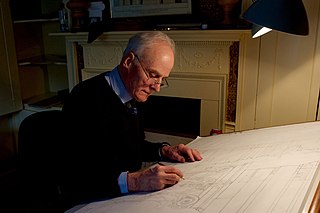
An architect is a person who plans, designs and oversees the construction of buildings. To practice architecture means to provide services in connection with the design of buildings and the space within the site surrounding the buildings that have human occupancy or use as their principal purpose. Etymologically, the term architect derives from the Latin architectus, which derives from the Greek, i.e., chief builder.

Christopher Wolfgang John Alexander was an Austrian-born British-American architect and design theorist. He was an emeritus professor at the University of California, Berkeley. His theories about the nature of human-centered design have affected fields beyond architecture, including urban design, software, and sociology. Alexander designed and personally built over 100 buildings, both as an architect and a general contractor.

The American Institute of Architects (AIA) is a professional organization for architects in the United States. Its headquarters are located in Washington, D.C. The AIA offers education, government advocacy, community redevelopment, and public outreach programs, and collaborates with other stakeholders in the design and construction industries. The current leadership of the AIA includes Lakisha Ann Woods, CAE, serving as EVP/Chief Executive Officer, and Emily Grandstaff-Rice, FAIA, serving as the 2023 AIA President.

José Rafael Moneo Vallés is a Spanish architect. He won the Pritzker Prize for architecture in 1996, the RIBA Royal Gold Medal in 2003, and La Biennale's Golden Lion in 2021.
Ken Yeang is an architect, ecologist, planner and author from Malaysia, best known for his ecological architecture and ecomasterplans that have a distinctive green aesthetic. He pioneered an ecology-based architecture, working on the theory and practice of sustainable design. The Guardian newspaper (2008) named him "one of the 50 people who could save the planet". Yeang's headquarters is in Kuala Lumpur (Malaysia) as Hamzah & Yeang, with offices in London (UK) as Llewelyn Davies Ken Yeang Ltd. and Beijing (China) as North Hamzah Yeang Architectural and Engineering Company.

John Quinlan Terry CBE is a British architect. He was educated at Bryanston School and the Architectural Association School of Architecture. He was a pupil of architect Raymond Erith, with whom he formed the partnership Erith & Terry.

Balkrishna Vithaldas Doshi OAL was an Indian architect. He is an important figure in Indian architecture and noted for his contributions to the evolution of architectural discourse in India. Having worked under Le Corbusier and Louis Kahn, he was a pioneer of modernist and brutalist architecture in India.
The Prince Claus Fund was established in 1996, named in honor of Prince Claus of the Netherlands. It receives an annual subsidy from the Dutch Ministry of Foreign Affairs.

Simón Vélez is a prize-winning Architect from Colombia, most famous for his innovative use of Guadua bamboo as an essential building component. Vélez was born in Manizales, Colombia, in 1949. His father and grandfather were also architects. He has designed buildings in over 11 countries.

Alexander Tzonis is a Greek-born architect, author, and researcher. He has made contributions to architectural theory, history and design cognition, bringing together scientific and humanistic approaches in a synthesis. Since 1975, he has been collaborating in most projects with Liane Lefaivre. In 1985, he founded and directed Design Knowledge Systems (DKS), a multidisciplinary research institute for the study of architectural theory and the development of design thinking tools at TU Delft. Tzonis is known for his work on the classical canon, history of the emergence and development of modern architectural thinking, creative design by analogy, and introducing the idea of critical regionalism.

Daryl Sanders Jackson AO is an Australian architect and the owner of an international architecture firm, Jackson Architecture. Jackson also became an associate professor at University of Melbourne and Deakin University.

William Kerry Hill AO was a Singapore-based, Australian architect who specialised in hotel design in tropical Asia. His works were known for their features of steeply-pitched pavilion roofs, shaded walkways, and an abundance of water features, affectionately dubbed the "Kerry Hill touch".

Eyal Weizman MBE FBA is a British Israeli architect. He is the director of the research agency Forensic Architecture at Goldsmiths, University of London where he is Professor of Spatial and Visual Cultures and a founding director there of the Centre for Research Architecture at the department of Visual Cultures. In 2019 he was elected Fellow of the British Academy.
Arif Hasan, is a Pakistani architect, planner, activist, social researcher, and writer. He is a recipient of Hilal-i-Imtiaz, the country's second highest award for its citizens.
Mick Pearce is a Zimbabwean architect.

Wu Liangyong is a Chinese architect and urban planner. He was a former professor in urban planning, architecture, and design. In preparation to the 2008 Summer Olympics in Beijing, he was leading the team that studied the buildings of the games. He is considered the most influential architect and urban planner in China.
Decolonizing Architecture Art Residency (DAAR) is an architectural studio, collective of architects and a residency program based in Beit Sahour, Palestine. DAAR was established to work on complex architectural problems in a region with strongly conflicting political forces, and is related to the Decolonizing Architecture Art Research collective.

New Classical architecture, New Classicism or Contemporary Classical architecture is a contemporary movement in architecture that continues the practice of Classical architecture. It is sometimes considered the modern continuation of Neoclassical architecture, even though other styles might be cited as well, such as Gothic, Baroque, Renaissance or even non-Western styles – often referenced and recreated from a postmodern perspective as opposed to being strict revival styles.
Liane Lefaivre, a Canadian and an Austrian, is o-Professor of Architectural History and Theory at the University of Applied Art in Vienna Austria, now retired.

Mariam Issoufou Kamara is a Nigerien architect. Her designs focus on open living spaces and make use of locally produced materials available to African communities: cement, recycled metal and raw earth.













